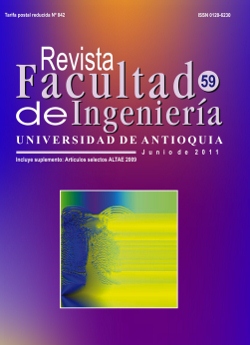JMat – Multiuser and remote calculation software tool for the problem based learning using Matlab
DOI:
https://doi.org/10.17533/udea.redin.13771Keywords:
JAVA, EJS, cliente / servidor, Matlab, remoto, multiusuarioAbstract
JMat is a software calculation tool developed on JAVA and EJS (Easy Java Simulations), client/server-based, multiuser support and remote access to Matlab. The main goal of the calculation software tool is to offer to remote users an interaction with Matlab using its three interfaces: Command Console, where users executes Matlab text commands; Work Space and Plotting, where automatically the remote user variables are stored and plotted individually; Functions and File Transfer, where users functions can be created, and data can be send or receive to and from a server. JMat requires an Internet access, a PC server with Matlab installed, and a client (WEB browser or stand-alone application). It is not necessary a Matlab on client side. Actually, JMat is being used at Universidad of Valle in courses like Automatic Process Control, Intelligent Control, Artificial Neural Networks, Signal Processing and Digital Image Processing as a tool for problem-based learning through the University of Valle’s eLearning platform.
Downloads
References
L. Uden, C. Beaumont. “Technology and Problembased Learning”. Information Science Publishing. Vol. 2006. pp. 1-207.
E. Graaff, A. Kolmos. “Management of Change: Implementation of Problem-Based and Project-Based Learning in Engineering”. Sense Publishers. Vol. 2007. pp. 113-215. DOI: https://doi.org/10.1163/9789087900922
S. L. Toral, F. J. Barrero. “Implementation of a webbased educational tool for digital signal processing teaching using the technological acceptance model.” IEEE Transactions on Education. Vol. 48. 2005. pp. 632-641. DOI: https://doi.org/10.1109/TE.2005.853074
H. Hassan, C. Dominguez, J. Martinez, A. Perles, J. Albaladejo. “Remote laboratory architecture for the validation of industrial control applications.” IEEE Transactions on Industrial Electronics. Vol. 54. 2007. pp. 3094-3102. DOI: https://doi.org/10.1109/TIE.2007.907015
Y. Liao, C. Sun. “An educational genetic algorithms learning tool.” IEEE transactions on Education. Vol. 44. 2001. pp. 20 DOI: https://doi.org/10.1109/13.925863
J. Jantzen. “Internet learning in control engineering: A fuzzy control course.” 6th IFAC Symposium on Advances in Control Education. ACE 2003. Oulu (Finland). pp. 27–35.
J. Sanchez, S. Dormido, R. Pastor, F. Morilla. “A Java/ Matlab-based environment for remote control system laboratories: illustrated with an inverted pendulum.” IEEE Transactions on Education. Vol. 47. 2004. pp. 321-329. DOI: https://doi.org/10.1109/TE.2004.825525
B. Doğan, H. Erdal. System Control Through the Internet and a Remote Access Laboratory Implementation. Ed. Springer. Berlin (Germany). 2007. pp. 532-541. DOI: https://doi.org/10.1007/978-3-540-78139-4_47
P. Bistak. “Matlab and Java based virtual and remote laboratories for control engineering”. 17th Mediterranean Conf. on Control and Auto. June 24-26. 2009. Thessaloniki (Greece).Vol. 1. 2009. pp. 1439- 1444. DOI: https://doi.org/10.1109/MED.2009.5164749
Y. Sheng, W. Wang, J. Wang, J. Chen. “A Virtual Laboratory Platform Based on Integration of Java and Matlab.” In Proc. of the 7th int. conf. on Advances in Web Based Learning. Jinhua (China). Vol. 5145. 2008. pp. 285-295. DOI: https://doi.org/10.1007/978-3-540-85033-5_28
http://www.um.es/fem/EjsWiki/. Consultada el 12 de febrero de 2010.
J. Ramírez, E. Caicedo, H. Loaiza, E. Bacca, C. Pinedo. “Platform for Signals and Systems Internet-Based Education, International Technology.” Education and Development Conference. Valencia (España). Vol. 1. 2008. pp. 558-564.
J. Ramírez, E. Caicedo, H. Loaiza, E. Bacca. Plataforma de Procesamiento Distribuido y Emulación de Sistemas Dinámicos con Acceso Remoto Multiusuario para Educación e Investigación en Ingeniería. COLCIENCIAS. Contrato N.° 234. 2005. pp. 9
http://java.sun.com/javase/. Consultada el 14 de febrero de 2010.
http://www.cs.virginia.edu/~whitehouse/. Consultada el 14 de febrero de 2010.
J. Sterling, G. Catuche, E. Bacca. “Seguimiento de Trayectorias y Objetivos en Tierra usando un Dirigible y Visión Artificial.” Rev. Fac. Ing. Univ. Antioquia. Vol. 50. 2009. pp. 122-134
T. Fossen. Guidance and Control of Ocean Vehicles. Ed. John Wiley & Sons. Chichester (England) 2003. pp. 5-162.
S. Van der Zwaan. Vision Based Station Keeping and Docking for Floating Robots. Msc. Thesis, Lisboa– Portugal, Instituto Superior Técnico. Vol. 1. 2001. pp. 47-61. DOI: https://doi.org/10.23919/ECC.2001.7076375
M. Restivo, J. Mendes, A. Lopes, C. Silva. F. Chouzal. “A Remote Laboratory in Engineering Measurement,” Ind.Elec. IEEE Trans. On. Vol. 56. 2009. pp. 4836- 4843. DOI: https://doi.org/10.1109/TIE.2008.2011479
M. Koretsky, D. Amatore, C. Barnes, S. Kimura. “Enhancement of Student Learning in Experimental Design Using a Virtual Laboratory,” Edu. IEEE Trans. Vol.51. 2008. pp. 76-85 DOI: https://doi.org/10.1109/TE.2007.906894
http://campusvirtual.univalle.edu.co/. Consultada el 14 de febrero de 2010.
http://www.renata.edu.co/. Consultada el 14 de febrero de 2010.
R. Ledesma. “AlphaCI: un programa de cálculo de intervalos de confianza para el coeficiente alfa de Cronbach,” Psico-USF. Vol. 9. 2004. pp. 31-37. DOI: https://doi.org/10.1590/S1413-82712004000100005
Downloads
Published
How to Cite
Issue
Section
License
Copyright (c) 2018 Revista Facultad de Ingeniería

This work is licensed under a Creative Commons Attribution-NonCommercial-ShareAlike 4.0 International License.
Revista Facultad de Ingeniería, Universidad de Antioquia is licensed under the Creative Commons Attribution BY-NC-SA 4.0 license. https://creativecommons.org/licenses/by-nc-sa/4.0/deed.en
You are free to:
Share — copy and redistribute the material in any medium or format
Adapt — remix, transform, and build upon the material
Under the following terms:
Attribution — You must give appropriate credit, provide a link to the license, and indicate if changes were made. You may do so in any reasonable manner, but not in any way that suggests the licensor endorses you or your use.
NonCommercial — You may not use the material for commercial purposes.
ShareAlike — If you remix, transform, or build upon the material, you must distribute your contributions under the same license as the original.
The material published in the journal can be distributed, copied and exhibited by third parties if the respective credits are given to the journal. No commercial benefit can be obtained and derivative works must be under the same license terms as the original work.










 Twitter
Twitter